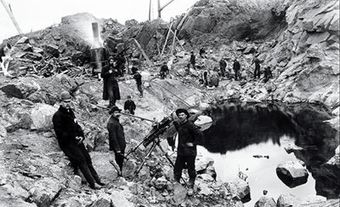Silica
Silica, or silicon dioxide (SiO2), occurs as the MINERAL quartz and is the most abundant mineral of the Earth's crust. It also occurs in the skeletal parts of some animals (eg, certain protozoa) and various plants. Quartz forms hexagonal crystals and melts at 1723°C; it has a low thermal coefficient of expansion and is very resistant to weathering. Pure quartz is colourless, but the colour of GEMSTONES such as amethyst, rose quartz, citrine, cairngorm (smoky quartz), and jasper results from impurities. Silica is found as loose, unconsolidated quartz grains (eg, beach sand), sandstone, quartzite, vein quartz, or pegmatitic quartz; in the last 3 forms silica can sometimes be found in a very pure state and used in the production of high value-added products.
Silica is used in the manufacture of glass containers (bottles, tableware) and flat glass (windows and automotive glass). Metallurgical-grade silicon is used in the aluminum industry; chemical grade is used to produce silicones; and the highest purity is used to produce silicon chips. Other uses for silica include ferro silicon for the steel industry, silicon carbide (as an abrasive and refractory), cultured quartz for oscillators, sodium silicate "water glass" for the pulp industry and as a refractory, and fused silica as a filler in electronic components and for many other uses. Silica sand is used as a metallurgical flux to lower the melting point in the base metal industry; as foundry sand for metal castings; as frac-sand to increase porosity and thus increase oil and gas recovery; as an abrasive for sandblasting; and as filler material in tile, asbestos pipe, concrete and bricks.
Silica deposits occur throughout Canada. However, to be economically viable and for low-tech and low-value but large-volume applications such as glass containers and flat glass, a deposit should be 95-99% pure, easily mined by the open pit method and close to a market. Because electricity is very competitive in several regions of Canada, new silicon carbide, cultured quartz, fused silica and silicon metal plants could be built in Canada. Canada's main producers of silica are Québec, Ontario and Alberta. Silica is also produced in Saskatchewan, British Columbia, Nova Scotia and Newfoundland and Labrador. Canada produces over 2 million t of silica annually.

 Share on Facebook
Share on Facebook Share on X
Share on X Share by Email
Share by Email Share on Google Classroom
Share on Google Classroom

